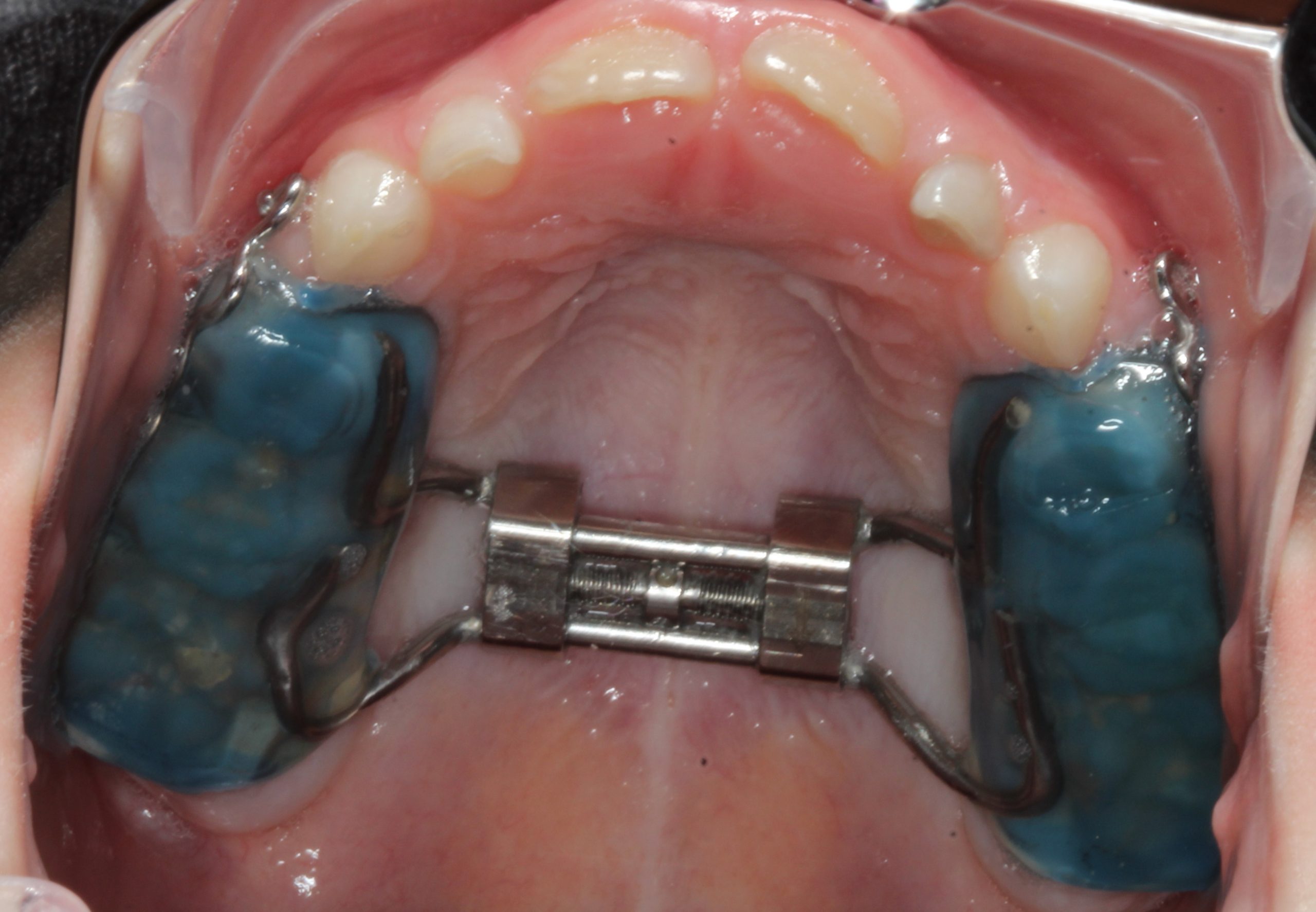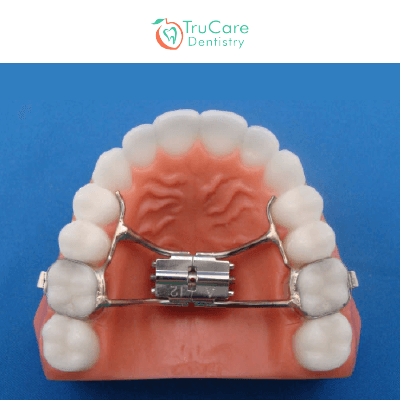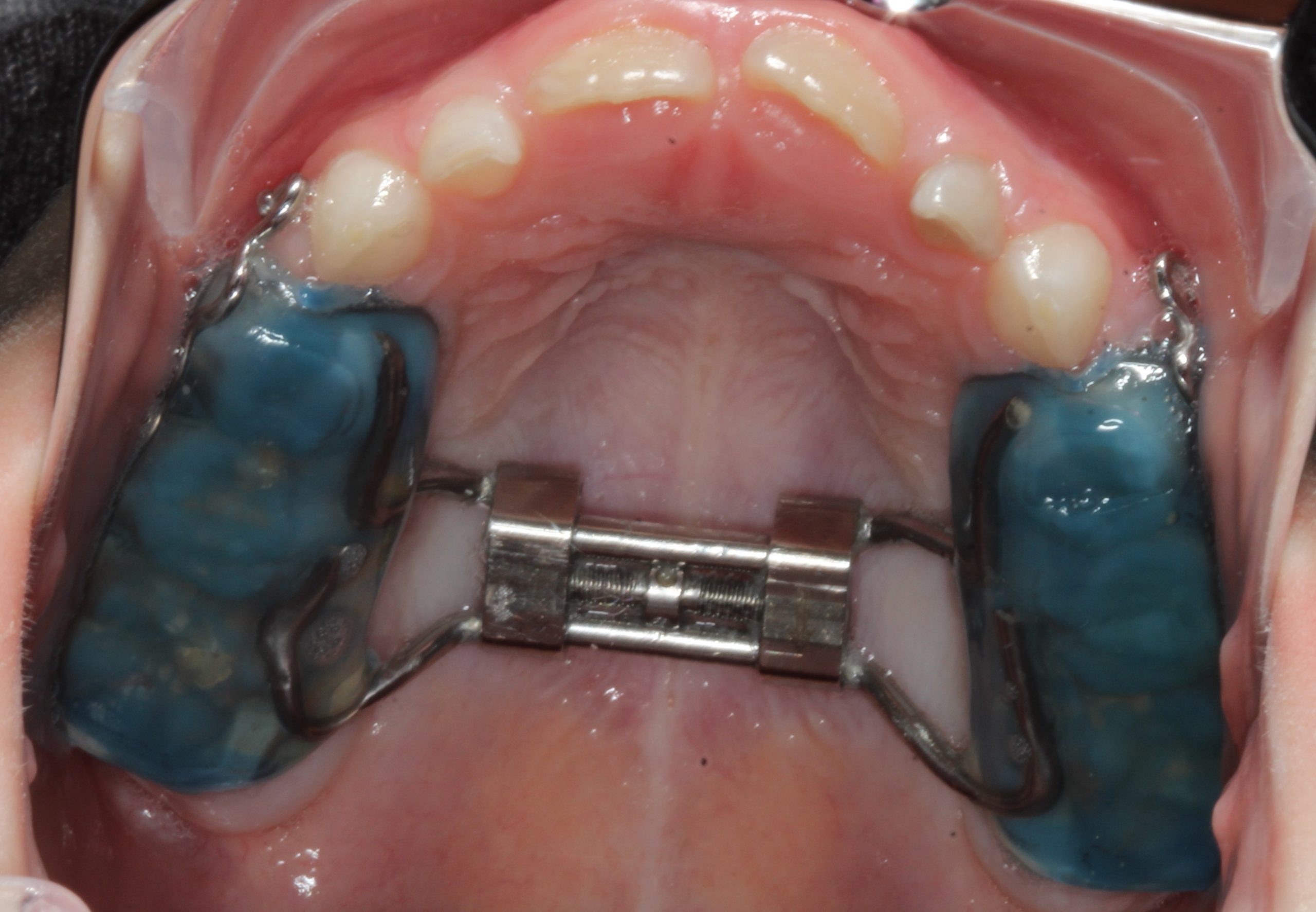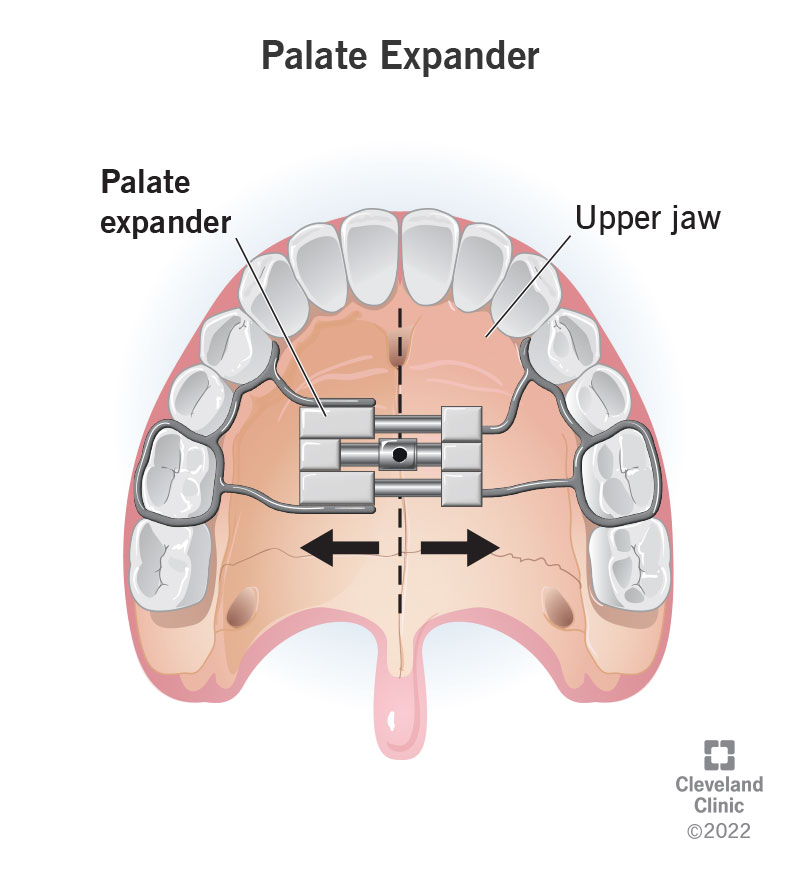https://upload.wikimedia.org/wikipedia/commons/c/ca/1×1.png
In addition to these two common types, there are also hybrid expanders that combine the features of both the RPE and SARPE. These hybrid expanders are designed to provide the benefits of both types while minimizing the drawbacks. They can be adjusted by the orthodontist or the patient’s caregiver, and the expansion process can be completed in a shorter period of time.
Overall, palatal expanders are an effective orthodontic treatment option for correcting issues related to the upper jaw. The type of expander used will depend on the specific needs of the patient, as determined by the orthodontist. By widening the palate, palatal expanders can help create a more harmonious bite and improve overall dental health.
Rapid Maxillary Expander
The Rapid Maxillary Expander (RME) is a type of palatal expander commonly used in orthodontic treatment. It is designed to widen the upper jaw, or maxilla, in order to correct dental and skeletal issues such as crossbites, crowding, and narrow arches.
How does it work?

The RME works by applying gentle and controlled pressure on the upper jaw, gradually separating the two halves of the palate. This expansion creates more space for the teeth to align properly and improves the overall harmony of the facial structures.
The expander consists of a metal framework that is bonded to the back molars on both sides of the mouth. It also includes a screw mechanism in the middle that can be activated by the orthodontist. By turning the screw a small amount each day, the patient can gradually widen the expander and achieve the desired expansion.
Benefits of Rapid Maxillary Expander
The use of a Rapid Maxillary Expander offers several benefits for orthodontic patients:
- Widening of the upper jaw: The RME can effectively widen the upper jaw, creating more space for crowded teeth and improving the overall balance of the face.
- Treatment of crossbites: Crossbites occur when the upper teeth bite inside the lower teeth. The RME can help correct this issue by expanding the upper jaw and aligning the bite.
- Improved breathing and speech: In some cases, a narrow upper jaw can contribute to breathing problems and speech difficulties. By widening the jaw, the RME can help alleviate these issues.
- Shorter treatment time: The RME can help speed up the orthodontic treatment process by creating more space for teeth to move into their proper positions.
Haas Expander
The Haas expander is a type of palatal expander used in orthodontic treatment to widen the upper jaw. It is named after its creator, Dr. Ravindra Nanda Haas, who developed the device in the 1980s.
The Haas expander consists of a metal framework that is custom-made to fit the patient’s mouth. It is typically attached to the upper molars using bands or rings, and it extends across the roof of the mouth. The expander has a screw mechanism in the middle, which allows for gradual expansion of the upper jaw.
During the initial placement of the Haas expander, the screw is activated by turning it with a special key. This puts pressure on the palatal bones, causing them to separate and create space. The patient may experience some discomfort during this process, but it is generally well-tolerated.
Once the desired amount of expansion is achieved, the Haas expander is left in place for a period of time to allow for stabilization of the newly widened jaw. This is usually followed by a retention phase, during which a retainer is worn to maintain the expansion.
The Haas expander is effective in correcting crossbites, crowding, and other dental issues caused by a narrow upper jaw. It can also help improve breathing and speech problems associated with a constricted palate.
| Pros | Cons |
|---|---|
| Effective in widening the upper jaw | Discomfort during activation |
| Can correct crossbites and crowding | Requires supervision of an orthodontist |
| Improves breathing and speech problems | Retention phase may be necessary |
Quad Helix Expander
The Quad Helix Expander is a type of palatal expander used in orthodontic treatment. It is designed to widen the upper jaw and create more space for crowded teeth. The Quad Helix Expander consists of a metal framework that is custom-made to fit the roof of the mouth.
How it works:
The Quad Helix Expander is attached to the molars using bands or rings. It has four helical springs that exert gentle pressure on the teeth, gradually widening the upper jaw. The springs are adjusted by the orthodontist at regular intervals to achieve the desired expansion.
Benefits:
The Quad Helix Expander is a versatile appliance that can be used to correct a variety of orthodontic issues. It can help create space for crowded teeth, correct crossbites, and improve the alignment of the upper and lower jaws. It is also relatively easy to adjust and does not require frequent visits to the orthodontist.
Procedure:
The Quad Helix Expander is typically placed in the mouth after the initial phase of orthodontic treatment. The orthodontist will take impressions of the patient’s teeth and send them to a dental laboratory to create a custom-made expander. Once the expander is ready, it is cemented or bonded to the molars using bands or rings.
Duration of treatment:
The duration of treatment with a Quad Helix Expander varies depending on the individual case. In general, the expander is worn for several months to achieve the desired expansion. After the desired expansion is achieved, the expander is typically left in place for a few more months to allow the jaw to stabilize.
Aftercare:
After the Quad Helix Expander is removed, the patient may be required to wear a retainer to maintain the expansion and prevent relapse. The orthodontist will provide specific instructions on how to care for the expander and when to return for follow-up appointments.
Conclusion:
The Quad Helix Expander is an effective orthodontic appliance for widening the upper jaw and creating space for crowded teeth. It offers numerous benefits and can be used to correct a variety of orthodontic issues. If you are considering orthodontic treatment, consult with an orthodontist to determine if the Quad Helix Expander is the right option for you.
Hyrax Expander
The Hyrax expander is a type of palatal expander commonly used in orthodontic treatment. It is named after its inventor, Dr. Wilhelm Hyrax. This expander is designed to widen the upper jaw and create more space for crowded teeth.
The Hyrax expander consists of a metal framework that is attached to the upper molars using bands or rings. It has a screw mechanism in the middle that allows for gradual expansion of the palate. By turning the screw with a special key, the expander applies gentle pressure on the palatal bones, causing them to separate and create more space.
One of the advantages of the Hyrax expander is its ability to achieve rapid expansion. The screw can be turned a few times a day, resulting in a noticeable increase in the width of the upper jaw within a short period of time. This makes it an ideal choice for patients who require quick correction of their dental arches.
Another benefit of the Hyrax expander is its versatility. It can be used to correct various dental issues, such as crossbites, crowding, and narrow arches. The expansion achieved with this device not only improves the alignment of the teeth, but also helps to create a more harmonious facial profile.
Overall, the Hyrax expander is a reliable and effective tool in orthodontics. It provides a non-invasive and conservative approach to widening the upper jaw, allowing for proper alignment of the teeth and improved facial aesthetics.
| Pros | Cons |
|---|---|
| – Rapid expansion | – Discomfort during initial adjustment |
| – Versatile in treating various dental issues | – Requires regular activation by the patient |
| – Non-invasive and conservative approach | – Potential for relapse if not followed by retention |
Schwarz Expander
The Schwarz Expander is a type of palatal expander used in orthodontic treatment to widen the upper jaw. It is named after its inventor, Dr. William Schwarz. This expander is commonly used to correct crossbites, crowding, and other dental irregularities.
The Schwarz Expander consists of a metal framework that is custom-made to fit the patient’s palate. It is typically attached to the molars using bands or rings. The expander has a screw mechanism in the middle, which allows for gradual expansion of the upper jaw over time.
How it works
When the patient turns the screw on the Schwarz Expander, it exerts gentle pressure on the palatal bones, causing them to gradually move apart. This creates more space in the upper jaw, allowing for proper alignment of the teeth and improving the overall bite.
The expansion process with the Schwarz Expander usually takes several weeks or months, depending on the individual case. The patient is instructed to turn the screw a certain number of times each day, as directed by the orthodontist.
Advantages
One of the main advantages of the Schwarz Expander is its effectiveness in widening the upper jaw. It can address various orthodontic issues, such as crossbites, crowding, and narrow arches. The gradual expansion allows for a more comfortable and controlled treatment process.
Additionally, the Schwarz Expander is relatively easy to use and maintain. Patients can easily turn the screw themselves, following the orthodontist’s instructions. The expander is also removable, which allows for better oral hygiene and reduces the risk of plaque buildup.
Conclusion
The Schwarz Expander is a valuable tool in orthodontic treatment for correcting dental irregularities and widening the upper jaw. With its custom-made design and gradual expansion mechanism, it provides effective and comfortable treatment for patients. If you have any concerns about your upper jaw or bite, consult with an orthodontist to see if the Schwarz Expander is a suitable option for you.
W-arch Expander
The W-arch expander is a type of palatal expander used in orthodontic treatment to widen the upper arch of the mouth. It is named after its unique W-shaped design, which allows for controlled expansion of the palate. The W-arch expander is commonly used in cases where there is a narrow upper arch or a crossbite.
How does it work?
The W-arch expander consists of two halves that are connected by a central screw. The screw is turned periodically to gradually widen the expander and create space in the upper arch. The W-shaped design of the expander helps distribute the force evenly, reducing the risk of discomfort or pressure points.
During the treatment process, the patient will visit the orthodontist regularly to have the expander adjusted. The orthodontist will use a special key to turn the screw, gradually widening the expander. This process is usually painless, although some patients may experience slight pressure or discomfort.
Benefits of the W-arch expander
The W-arch expander offers several benefits for patients undergoing orthodontic treatment:
- Widening the arch: The main purpose of the W-arch expander is to widen the upper arch, creating more space for crowded or misaligned teeth. This can help improve the overall alignment of the teeth and create a more harmonious smile.
- Treatment of crossbites: The W-arch expander is particularly effective in treating crossbites, where the upper teeth bite inside the lower teeth. By widening the upper arch, the expander helps align the upper and lower teeth properly.
- Improved breathing and speech: In some cases, a narrow upper arch can lead to breathing difficulties or speech problems. By expanding the arch, the W-arch expander can help improve airflow and enhance speech clarity.
Conclusion

The W-arch expander is a valuable tool in orthodontic treatment, particularly for patients with a narrow upper arch or crossbite. Its unique W-shaped design allows for controlled and gradual expansion of the palate, resulting in improved dental alignment and overall oral health. If you have concerns about the width of your upper arch, consult with an orthodontist to determine if a W-arch expander is the right treatment option for you.
Transpalatal Arch Expander
The transpalatal arch expander is a type of palatal expander that is commonly used in orthodontic treatment. It is designed to widen the upper jaw, or maxilla, to create more space for crowded teeth and improve the alignment of the bite. This appliance is typically used in cases where the upper jaw is narrow and needs expansion.
How does it work?
The transpalatal arch expander consists of a metal bar that is attached to the molars on both sides of the upper jaw. It is designed to exert gentle pressure on the palate, or roof of the mouth, to gradually widen the jaw over time. The appliance is adjusted periodically by an orthodontist to increase the amount of expansion as needed.
During the initial appointment, the orthodontist will take impressions of the patient’s teeth and create a custom-made transpalatal arch expander. The appliance is then cemented or bonded to the molars using dental cement. The patient will be instructed on how to activate the expander using a special key, which is inserted into the expander and turned to apply pressure on the palate.
Benefits of the transpalatal arch expander
The transpalatal arch expander offers several benefits for patients undergoing orthodontic treatment:
- Widening of the upper jaw: The main purpose of the transpalatal arch expander is to widen the upper jaw, creating more space for crowded teeth and improving the overall alignment of the bite.
- Treatment of crossbites: The appliance can also be used to correct crossbites, where the upper teeth bite inside the lower teeth. By widening the upper jaw, the transpalatal arch expander helps to align the upper and lower teeth properly.
- Improved breathing and speech: In some cases, a narrow upper jaw can lead to breathing difficulties and speech problems. By expanding the upper jaw, the transpalatal arch expander can help improve these issues.
- Minimally invasive: The transpalatal arch expander is a relatively non-invasive treatment option compared to other orthodontic appliances. It does not require surgery or extractions, making it a popular choice for both children and adults.
Overall, the transpalatal arch expander is an effective tool for widening the upper jaw and creating more space for crowded teeth. It offers several benefits for patients undergoing orthodontic treatment and can help improve the overall alignment of the bite. If you have a narrow upper jaw or crowded teeth, consult with an orthodontist to determine if the transpalatal arch expander is the right treatment option for you.
Fan-type Expander
The fan-type expander is a type of palatal expander that is commonly used in orthodontic treatment. It is designed to widen the upper jaw and create more space for crowded teeth or to correct a narrow palate. The fan-type expander gets its name from its shape, which resembles a fan when viewed from the front.
How it works
The fan-type expander consists of a metal framework that is custom-made to fit the patient’s palate. It is typically attached to the upper molars using bands or rings. The expander has a screw mechanism in the center, which can be adjusted by the orthodontist to gradually widen the upper jaw.
When the screw is turned, the fan-type expander exerts gentle pressure on the palate, causing the bones to separate and create more space. This expansion can help correct issues such as crowding, crossbites, and narrow arches. The fan-type expander is usually worn for a period of several months, during which time the patient will visit the orthodontist for adjustments.
Benefits and considerations
The fan-type expander offers several benefits for patients undergoing orthodontic treatment. By widening the upper jaw, it can create more space for crowded teeth, allowing them to align properly. It can also help improve the bite and correct issues such as crossbites or narrow arches.
Coffin-type Expander
The Coffin-type expander is a type of palatal expander used in orthodontic treatment to widen the upper jaw. It is named after its inventor, Dr. Earl E. Coffin, who developed the device in the 1940s.
The Coffin-type expander consists of a metal framework that is custom-made to fit the roof of the mouth. It typically includes two bands that are cemented to the molars, a midline expansion screw, and two arms that extend towards the front of the mouth. The arms are connected to a central expansion screw, which is used to gradually widen the palate.
How it works
When the Coffin-type expander is activated, the central expansion screw is turned using a key. This causes the two arms to move apart, applying pressure to the palatal bones. Over time, this pressure stimulates bone growth and allows the upper jaw to widen.
The Coffin-type expander is typically worn for a period of several months, during which the expansion screw is turned regularly to achieve the desired amount of expansion. After the desired expansion is achieved, the expander is usually left in place for a few more months to allow the newly formed bone to stabilize.
Advantages and Disadvantages
https://upload.wikimedia.org/wikipedia/commons/c/ca/1×1.png
One advantage of the Coffin-type expander is that it is relatively simple and easy to use. It also allows for controlled and gradual expansion of the palate, which can help minimize discomfort for the patient.
However, the Coffin-type expander does have some limitations. It is not suitable for all patients, particularly those with certain dental or skeletal conditions. Additionally, the Coffin-type expander can be bulky and may cause speech difficulties or discomfort in some patients.
Microimplant-assisted Rapid Palatal Expander
The Microimplant-assisted Rapid Palatal Expander is a type of palatal expander used in orthodontic treatment to correct a narrow upper jaw or crossbite. It is a fixed appliance that is attached to the upper molars and uses microimplants for additional stability and support.
How it works
The Microimplant-assisted Rapid Palatal Expander consists of a framework that is bonded to the upper molars using dental cement. It also includes two microimplants, which are small titanium screws that are inserted into the palate bone for additional anchorage.
Once the appliance is in place, the orthodontist activates it by turning a key or screw. This activates the expansion mechanism, which gradually widens the upper jaw. The microimplants provide stability and prevent any unwanted movement during the expansion process.
Advantages
One of the main advantages of the Microimplant-assisted Rapid Palatal Expander is its ability to achieve rapid and controlled expansion of the upper jaw. The use of microimplants allows for greater stability and reduces the risk of relapse after treatment.
Additionally, this type of palatal expander is minimally invasive and does not require any surgical procedures. The microimplants are inserted into the palate bone under local anesthesia, and the expansion process is performed entirely within the mouth.
Considerations
It is also important for patients to follow the orthodontist’s instructions for activating the expander and maintaining proper oral hygiene. Regular check-ups are necessary to monitor the progress of the expansion and make any necessary adjustments.
| Pros | Cons |
|---|---|
| Allows for rapid and controlled expansion | May not be suitable for all patients |
| Minimally invasive | Requires regular check-ups and adjustments |
| Provides stability and reduces risk of relapse |
Removable Palatal Expander
A removable palatal expander is a type of orthodontic appliance that is used to widen the upper jaw. It is typically made of acrylic and metal components, and it can be easily taken in and out of the mouth by the patient. This type of expander is often used in cases where there is a need for gradual expansion of the palate.
How does it work?
The removable palatal expander works by applying gentle pressure on the upper jaw, which helps to widen the arch. It consists of two halves that are connected in the middle with a screw mechanism. By turning the screw, the two halves of the expander gradually move apart, creating space for the expansion of the upper jaw.
Benefits
There are several benefits to using a removable palatal expander:
- Customizable: The expander can be adjusted to meet the specific needs of each patient. The orthodontist can determine the amount of expansion required and make the necessary adjustments to the appliance.
- Improved bite: By widening the upper jaw, a removable palatal expander can help improve the bite and alignment of the teeth.
- Enhanced breathing and speech: In some cases, a narrow upper jaw can lead to breathing difficulties and speech problems. By expanding the palate, a removable palatal expander can help alleviate these issues.
- Non-invasive: Unlike other types of expanders, a removable palatal expander does not require any surgery or invasive procedures. It can be easily inserted and removed by the patient.
Fixed Palatal Expander
A fixed palatal expander is a type of orthodontic appliance that is used to widen the upper jaw. It is typically used in cases where there is a narrow palate or a crossbite. The fixed palatal expander is attached to the teeth and cannot be removed by the patient.
How Does It Work?
The fixed palatal expander works by applying gentle pressure to the upper jaw, gradually widening it over time. The appliance consists of two metal bands that are cemented to the molars and connected by a metal bar that spans the roof of the mouth. The metal bar is turned using a special key, which activates the expansion mechanism.
When the key is turned, the metal bar pushes against the molars, causing the upper jaw to widen. This process is typically done in small increments, with the patient turning the key a certain number of times each day or week. The expansion process can take several weeks or months, depending on the individual case.
Benefits of a Fixed Palatal Expander
A fixed palatal expander offers several benefits for patients who need to widen their upper jaw:
- Treatment of Crossbite: A fixed palatal expander can effectively correct a crossbite by widening the upper jaw and aligning the teeth properly.
- Improved Breathing and Speech: By expanding the upper jaw, a fixed palatal expander can create more space in the nasal cavity, improving breathing and reducing the risk of sleep apnea. It can also help improve speech by correcting any speech impediments caused by a narrow palate.
- Prevention of Dental Problems: A narrow upper jaw can lead to overcrowding of the teeth, making it difficult to maintain proper oral hygiene. By widening the jaw, a fixed palatal expander can create more space for the teeth, reducing the risk of dental problems such as cavities and gum disease.

Dr. Fidel Cann: Esteemed orthodontist with a lifelong dedication to enhancing smiles and oral health. Pioneering expertise, compassionate care.






